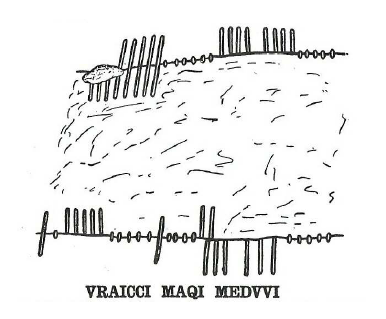2) Ogam inscription: Meduva?
An Ogam inscription found at the site of Rathcroghan, near Tusk (Co. Roscommon, Ireland), in the cave of Cruachnu - which is a natural rock fissure, to which a drystone masonry porch was added – is worth mentioning, even though its reconstitution and meaning remains problematic and hypothetical (fig. 7).2327 The Ogam VRAICCI MAQI MEDVVI is engraved on the lintel just inside the entrance.

Ó hÓgáin suggest that this Ogam means ‘Vracos son of Meduva’, and refers to the goddess Medb, the antique name of which would have been Meduva.2328According to him, this Ogam can be dated from the 6th c. AD because the legend of Queen Medb, first attached to Teamhair (Tara, Leinster) was brought by the powerful Connachta sept* to the impressive site of Cruachain during the 5th c. AD. The Connachta gained possession of Teamhair in or about the 4th c. and decided to build another stronghold in the western part of Ireland at this time.2329 Vracos may have been a noble of the Connachta since his filiation is divine. An example of a personal name denoting divine filiation to the goddess of mead-intoxication is also found in Gaul. The proper name Medugenos can indeed mean ‘Born of honey, mead, intoxication’ or ‘Descendant of the goddess of mead-intoxication’.2330 Olmsted points out that the use of the suffixes geno-, ‘lineage’ or ‘born of’ and gnato-, ‘son of’, usually expresses mythological filiation, such as in Boduo-gnatos and Boduo-genus, which can be either glossed as ‘Son of the Crow’, or more likely as ‘Born of Bodua’, that is the Irish crow war-goddess.2331 Likewise, the personal names Camulogenus, the leader of the Aulerci in Gallia Lugudensis,2332 and feminine Camulognata, mentioned in an inscription from Berthouville (Eure),2333 also give filiation from the god Camulos (‘Warrior’ or ‘Of Conflict?’).2334 In view of these Gaulish personal names, the Ogam inscription of Rathcroghan could therefore mention the divine filiation of a man, Vracos, from the goddess Medb. The name Vracos might be related to the divine name Fraech, meaning ‘heather’ (from Irish froích, fróech, ‘heather’), which would have been in archaic Irish, Vraecah, from Celtic Vroecos.2335 An epic tale, entitled Táin Bó Fraích [‘The Cattle Raid of Fraech’], tells that Fraech died and was interred in this very cave of Cruachnu.2336 One is tempted to think that this VRAICCI was the name of the mythical hero, and yet, in Irish mythology, Fraech is not the son of Medb, but the son of Bé Find, sister of Boand. Ó hÓgáin suggests that the original oral story was probably invented when somebody came into that cave and read the inscription (late 7th c.).2337
The interpretation of the Ogam script as ‘Vracos, son of Meduva’ is, however, unlikely, for Lambert points out that it is generally not the name of the mother which follows mac (‘son of’), but the name of the father.2338 Moreover, MEDVVI is uncontestably a masculine genitive, and thus MAQI MEDVVI means ‘son of Medvvos’. A feminine genitive could be conceivable after MAQI only if it is considered that the letters –AS are missing at the end of MEDVVI, for the genitive of Medb, which is Meidbe, is derived from a Celtic *Medwias. As for the name VRAICCI, it is problematic from a philological point of view, and could refer to the genitive of Fracc or Froéch. From this analysis, it ensues that this Ogam script is certainly not to be understood as an ancient epigraphical reference to the goddess Medb.